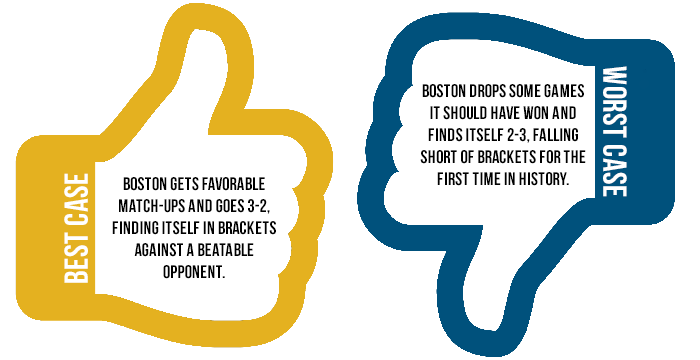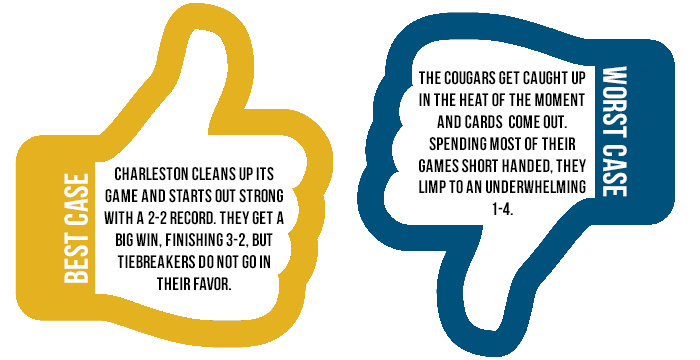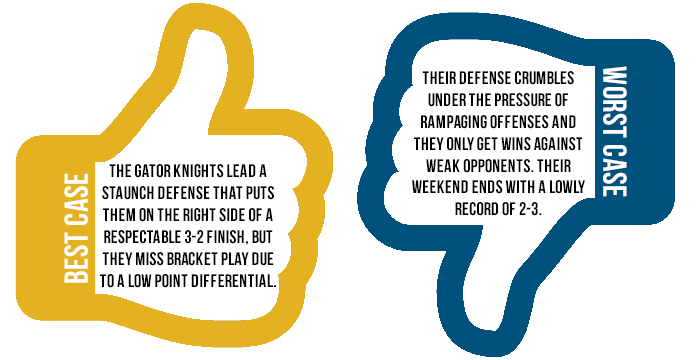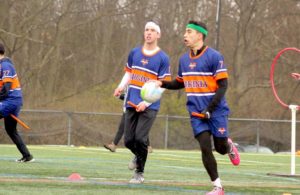- Rule, Britannia, no more?
- Unpopular Opinions: US Quadball Cup 2023
- Proven Contenders: University of Virginia
- Proven Contenders: Rutgers University
- Proven Contenders: University of Michigan
- Proven Contenders: Creighton University
- Different Perspectives: A Look Inside USA Ultimate
- Antwerp QC, Much of Belgian Core, Leaves Competitive Quidditch
Part XVIII
Rock Hill Roll Call is your in-depth guide to the 80 teams that will compete for the title of World Cup 8 Champion. We’ve reached out to writers and analysts all over the country to bring you the lineups, strategies, focal points and aspirations of each and every attending team. Whether you are looking for a leg up on the competition or just want a detailed preview of the sport’s main event, this is the place for you.
 By Eric Wasser
By Eric Wasser
Before starting their quidditch careers, nearly every player of relevance developed their skills playing other sports, and Bowling Green State University’s stars are no different. This year, the Falcons have thrived by placing the appropriate transitional athletes in front of their hoops.
Bringing an otherwise unseen level of physicality to Bowling Green’s lineup is keeper Zak Hewitt, a rugby player at heart who has earned himself widespread recognition following the squad’s recent victories. When teams manage to break through the Falcons’ beater-centric defense–a strategy known for forcing opponents’ long shots–Hewitt is there to physically push them back.
When Hewitt’s not on the pitch to take down the opposition, look to none other than The Eighth Man’s 2013 Sportsman of the Year Daniel Daugherty, who will swallow any shot that comes near his hoops. Despite his skill and experience at keeper, Daugherty has been making the transition to full-time chaser this season, but he has not handed his green headband to just anyone. The Falcons were lucky enough to acquire the Division I Bowling Green basketball walk-on and former high school state champion Mike Gallagher, who has fully committed himself to quidditch this year. Gallagher’s vertical leap, speed and explosiveness perfectly complement his team’s consistent beating, so he is quick to cover any breaches in the beaters’ generally solid defense.
Now, boasting the Hewitt-Gallagher keeper double threat, Daugherty has, as mentioned, been given the opportunity at chaser to range farther on offense, as well as give the team more pass defense off-ball. The combination of these three versatile athletes on the roster and a solid beating strategy promise a good showing for the Falcons at World Cup.
 By Anonymous
By Anonymous
Playing against Bowling Green this season is a little different from seasons past, but the team is in no way less difficult to face. Gone are the World Cup VI days of chaser Daugherty heaving 20-yard shots at the hoops and a defense based on the two-male beater sets that currently terrorize the Northeast. The Falcons now operate simultaneously more traditionally and with more variety than ever before.
On offense, the squad’s most notable change comes from the addition of standout sophomore keeper Gallagher. Gallagher played sparingly last season due to his status as a walk-on for Bowling Green’s varsity men’s basketball team. His full-time focus on quidditch this season has turned him from a raw, athletic talent into perhaps the best all-around keeper in the Midwest. To stop the Falcons’ offense, you need to answer to both Gallagher’s driving and his distributing abilities.
 The team also retained two of the best female chasers in the region: Meredith Taylor and Pari Yost. Yost combines her height with excellent hands near the hoops to become a goal-scoring machine, while Taylor has made a lot of progress this season becoming a secondary distributor. And, as always, Daugherty is a threat every minute he is on the pitch from any location within 15 yards of the hoops, granting Bowling Green the ability to score in a number of ways.
The team also retained two of the best female chasers in the region: Meredith Taylor and Pari Yost. Yost combines her height with excellent hands near the hoops to become a goal-scoring machine, while Taylor has made a lot of progress this season becoming a secondary distributor. And, as always, Daugherty is a threat every minute he is on the pitch from any location within 15 yards of the hoops, granting Bowling Green the ability to score in a number of ways.
Defensively, the Falcons’ story has not changed too much. A beating crew headlined by Chad Brown brings loads of experience and athleticism and can challenge anyone in the Midwest. Bowling Green only brought back three male chasers from last season’s roster, including Greg Smolkovich returning after a semester off, but all of the new additions have one thing in common: They can hit in a way Bowling Green lacked in years prior.
Daugherty has coached this half-court defense tremendously, and the strength of the team’s strategy lies primarily in its intelligence. There is not really a secret or trick to scoring on Bowling Green–you just have to maximize your offensive strengths, keep bludger control away from a very strong group of beaters and hope for the best.
Defeating Bowling Green has never been the easiest of tasks, and it comes down to a frustratingly simple answer. This is a top-level squad that has what it takes to return to the Final Four. The Falcons do not have many weaknesses, so to win, you really just have to play better than them for half an hour.
By David Fox
In case you haven’t heard yet, Boston University lost a huge chunk its team to graduation last year. No more Katrina Bossotti and Max Havlin terrorizing at beater. No more Brendan Stack and Michael Powell dominating the quaffle game. In the blink of an eye, the reins of this program were handed off to a predominantly new collection of players.
For most teams, undergoing such a huge shift could mean losing regional and national relevance. However, Boston is not your average program. The Terriers have reloaded their team with a group of promising new players, but the question remains: Can they develop into a cohesive unit before World Cup?
 Early in the fall, Boston was still finding its rhythm. The team’s chasers played hard but were not passing and moving with the crispness that had been commonplace the year before. Against the tough competition in Boston, the Terriers’ beaters found themselves overwhelmed. But by the Northeast Regional Championship, the squad was starting to look more like the powerhouse team of previous years. It stayed within one goal of Tufts University, who had destroyed Boston earlier in the semester.
Early in the fall, Boston was still finding its rhythm. The team’s chasers played hard but were not passing and moving with the crispness that had been commonplace the year before. Against the tough competition in Boston, the Terriers’ beaters found themselves overwhelmed. But by the Northeast Regional Championship, the squad was starting to look more like the powerhouse team of previous years. It stayed within one goal of Tufts University, who had destroyed Boston earlier in the semester.
To be fair, the record 100 inches of snow covering the city this winter has probably affected the Terriers’ practice times and ruined some crucial team-building opportunities. But do not write this squad off just yet–Boston’s x-factor is undoubtedly its ability to adapt and grow, and if it continues to demonstrate the same level of development it showed first semester, the Terriers will be in good shape come World Cup.
 By Anonymous
By Anonymous
On offense, Boston likes to station two players close together up top. One of them, usually the keeper, will drive until pressured by a beater and then try a short pass to the nearby chaser. The Terriers’ chasers are strong and fast, so if they get the quaffle behind the hoops without beaters close by, they are hard to stop. Those chasers are also willing to get physical on defense, despite most of them lacking the build to stop bigger opponents.
The beaters are led by Peter Cho, a fast, aggressive player with a quick trigger. He is the real standout amongst their beater corps; when Cho is off the field, the rest of the beaters struggle to retain control. Boston’s beaters will try to find the right balance between playing offensively and still being able to make it back to their hoops for a turnover. They did not fair well against more physical beaters earlier in the season, which could be a killer at World Cup if they do not strengthen up.
Losing Jon Goc to study abroad means that most of Boston’s possessions will end up in the hands of the team’s keeper, Dyllon Carson. He is a long, rangy player with good vision, but many of his passes fell short of their mark last semester. That is more indicative of him being new to the game, though, as it looks like he has the instincts to be a real threat.
 By Greg Astolfi
By Greg Astolfi
College of Charleston shocked the quidditch world with a surprise run into the South Regional Championship finals, where the team was eventually ousted by Florida’s Finest 190-150*. The results left many analysts with their jaws on the floor, wondering how a team with a losing record on the season could ever make it to a regional finals match. Though, if you have ever seen this team in person, you have probably been asking yourself why it took the Cougars this long to have a breakout performance.
Outside of Florida’s Finest, Charleston boasts one of the most athletic rosters in the South. However, up until the regional, this South Carolina team had struggled to put together a performance that would live up to its potential. The key for Charleston heading into Rock Hill will be discipline. If the Cougars can reign in their athletes and play a composed game, then they could see some success.
During the finals match against Florida’s Finest, Charleston showed brief 1- to 2-minute glimpses of solid gameplay, proving that when the Cougars are on their game, they can hang with any team in the South Region. During these intermittent spurts, Charleston showed a solid offense, neutralizing defensive beaters then subsequently driving and scoring mid-range shots and dunks. Furthermore, its chasers marked well on the defensive end and its beaters made key plays in order to stop quality scoring opportunities. Unfortunately, this hard work was all too often undone by a needless foul and resulting card.
During the finals match alone, Charleston took eight yellow cards–three of which would result in red cards. The Cougars will have to do their best to minimize taking these types of fouls in Rock Hill. No team can have success when it spends nearly a third of the game in the penalty box for cards including a hit and push from behind, tackling a player without a ball, cursing at the ref and a dangerous kick, to name a few. Nearly all of these fouls are preventable with a bit more discipline.
This team plays with a lot of energy and emotion, but it often leads to them getting caught up in the heat of the moment in big games. This is exactly what happened in the regional final. The Cougars were the heavy underdogs in a game on the verge of snitch range against a Top-20 opponent, and Charleston seemed to crack under this pressure, giving way to heated emotions that ultimately led to cards. With a little discipline, this team might have kept its cool long enough to walk away the South Regional champion.
Charleston will be unpredictable heading into April. It has the potential to hang with some top teams and fair well against the middle of the pack, but if it does not work on its discipline and avoid those cards, the Cougars will not have a very good showing in Rock Hill.
By Anonymous
With the amount of athleticism on Charleston’s roster, one would expect this team to be a tougher outing than it actually is most of the time. This team has the ability to play at a high level, but it has not seemed to put together a complete performance this season.
The Cougars’ offensive approach is usually straightforward. The chasers use a number of handoffs and short-range passes to gain width and open driving lanes. They are patient in allowing their beaters to get in front of the play, giving them time to either eliminate defensive beaters or attempt to regain control. When either the bludgers are down or a lane opens up, Charleston drives the quaffle, and this is where it is most adept. If you give this team space to drive, it will exploit the open lanes.
 The biggest threat of all is 6-foot-4 keeper Steven Schwark who possesses the ability to drive through contact and sink mid-range shots. Slowing down Schwark and his driving offense requires taking away the open lanes, forcing passes and marking big, physical players.
The biggest threat of all is 6-foot-4 keeper Steven Schwark who possesses the ability to drive through contact and sink mid-range shots. Slowing down Schwark and his driving offense requires taking away the open lanes, forcing passes and marking big, physical players.
Most of Charleston’s mid-range passes and longer either end up high and bouncing off the hands of the target or low near the ground. This creates many loose balls behind the goals and in the wide areas that result in turnovers. Teams that are quick to exploit these turnovers can often get easy, fast-break goals on the other end.
On defense, a point chaser rotates to focus on the primary quaffle carrier. The other two chasers mark man-to-man, while the keeper stays around the hoops to block down shots and stop drives. However, there is typically space up top for teams to run screens and give and gos. The beaters usually remain on the conservative side defensively, playing a front-back style with the top beater assisting at the point while the bottom beater hangs around the keeper zone.
In order to get through Charleston’s defense, one must first neutralize the beaters. Once the beaters are distracted, the opposing team can drive the quaffle toward the hoops. More often than not, this team will collapse on the ball carrier, leaving previously marked players wide open near the hoops. A quick dish-off pass to an open chaser will lead to goals.
Almost everyone on Charleston is athletic, and when the Cougars are on their game, they are not the easiest outing. Improved passing on offense and a tighter defense would help this team do well in April.
 By Sean Pagoada
By Sean Pagoada
In the preseason previews, University of Florida was given the title “Jack of all trades, master of none.” After seeing the team put forth a respectable performance at the South Regional Championship, this statement holds true. However, what the team lacks in mastery of skill, it makes up for with its cohesion.
Over winter break, the Florida lost a large chunk of its players, compensating by absorbing some of the unofficial University of Central Florida team. The new hybrid Gator Knights squad began its journey at the South Regional Championship. Under the guise of coach Tim Derrick, as well as captain Nick Zakoske, the team was able to make it just short of a semifinal run.
Florida does not boast the most athletic players of the state, but what it is a team of very coachable players. As individuals, the players are not very strong, but together they are a formidable unit. Day one of the South Regional Championship did not go so well for this team, losing close games to University of South Carolina and University of South Florida. When day two came around, the Gator Knights were scheduled to face off against Rollins College Quidditch Club–a team that had practiced together for an entire season. The Gator Knights did not lose their heads, though, and stuck to their game plan. With Zakoske at center of the defense, you could hear him directing the blockade from across the pitch. Beaters and chasers alike followed command after command, while ready to pounce on offense once the ball was secured in Zakoske’s hands. The result? An amazing win for them with the score of 190*-70 and a ticket to World Cup.
 By Anonymous
By Anonymous
Florida gave different looks defensively at the South Regional Championship, but the most prominent one shown was its University of Baylor-style defense. The team ran a two-male beater set with one man in front of the hoops and one behind and two female chasers guarding the hoops on either end with a point defender and a keeper behind the middle hoop. While the Gator Knights’ version is a bit more conservative on the beater side, it is set up for plenty of transition goals as well as drives behind the 1.5 bludger offense.
 Keeper Zakoske leads the communication on defense, making calls to his teammates to ensure no area is left unguarded. He is also the leading scorer on the team, always ready to take advantage of bludgerless drives.
Keeper Zakoske leads the communication on defense, making calls to his teammates to ensure no area is left unguarded. He is also the leading scorer on the team, always ready to take advantage of bludgerless drives.
The beaters leading the charge are Adam Treichel and Richard Crumrine. Rarely do the two play as a pair since they serve similar roles. Their job is to keep pressure on the ball carrier and make big hits on offense when given the opportunity.
On the quaffle side, chaser Jimmy Singer serves as an anchor for this team, with a knack for scoring against multiple quaffle players as well as bringing a great deal of physicality to the game. Keeper Kenny Stowe rotates with Zakoske, playing a similar on defense, leading communication and knocking down long-range shots. On offense, he is a smart, patient distributor.
The Gator Knights will try and frustrate opposing players with their defense and get them out of range early on. A team that likes to rush their offense will play right into their hands, so take your time, be patient and the game is yours.
Graphics and photo illustration by Amanda Dallas. Original photos by Monica Wheeler (top) and Will Michels (bottom).












